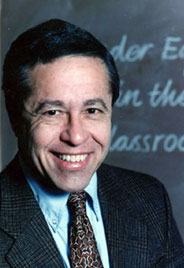
Succeeding at Fairness
For further information on keynote speeches and training workshops, contact:
David Sadker
6988 North Chula Vista Reserve Place
Tucson, AZ 85704
[email protected]
520-297-2319
EQUITY WORKSHOPS
Gender issues influence and shape learning in both formal and informal ways. Yet many educators, students, and parents are unable to detect, much less correct, the subtle biases that harm both girls and boys. This award-winning inservice training program empowers participants to become more equitable and effective teachers. The training is based on research studies from grade school through graduate school, and reflects more than 20 years of research studies and materials development by two of the nation's well known teacher educators, the late Myra Sadker and David Sadker. Programs offered include Keynotes as well as one, two and three day training experience.
SUGGESTED KEYNOTE TOPICS Is Gender Bias Still an Issue? And why are we asking this question? Where did the word “sexism” come from? Are girls still “victims” of sexism? Is there a “war” on boys? What does subtle classroom bias look like – and why does it persist? Through role play, videos and participant interaction, this keynote pulls together the last three decades of research to help educators understand the central role gender continues to play in the nation’s schools. What Can We Learn from Single Sex Schools and Classrooms? Some Practical Lessons for Teachers Single sex schools and classrooms receive much acclaim for their education of girls and women, yet much of what they do is not particularly related to the fact that they are single sex. Using a Dateline video on single sex classes done with Myra and David Sadker, participants analyze the “best practices” of single sex schools and develop strategies for more effective and equitable coeducation. Participants develop a list of a dozen strategies and techniques that they can implement to reduce or eliminate gender biased classroom behaviors.
|
FULL DAY TRAINING Behind the Classroom Door: Gender Bias in Schools Introductions and brief historical overview of gender bias in schools. Professional Communications: The Gender Communications Gap (Quiz) This quiz offers an enjoyable learning opportunity for participant interaction and discussion of how males and females communicate differently. The implications of these subtle differences, from who talks more to who touches more to who is more animated, allows individuals to understand the pervasive nature of gender differences, the academic and economic implications of these differences, and the connection between their behaviors outside the classroom, and their teaching behaviors within the classroom. The research is brought to life through role-play and small group participation. Analysis and Assessment of "Model" Teacher on Videotape This inductive process helps participants understand the subtle nature of classroom bias. The video, one of many used in teacher training institutions, portrays a typical teacher, and participants analyze the equity and effectiveness of the teacher. Role-Play: Gender Bias in the Classroom In order to emphasize the patterns of bias revealed by the research, a role-play is implemented with four "students" selected from the participants. The brief 10-minute reenactment manifests numerous examples of classroom bias. Participants are asked to identify and discuss salient examples of bias imbedded in the role-play. Review of the Research: Dateline NBC with Jane Pauley and the Sadkers The subtleties of interaction bias are made evident during the viewing of the Dateline segment that the Sadkers did with Jane Pauley in an Arlington, VA classroom. Cost of Gender Bias A review of the costs of gender differential treatment is presented, including the gender gap in standardized test performance, self-esteem measures, academic enrollment patterns, career choices and pay differences. Objective Data Gathering Techniques Participants are taught to use a modified version of INTERSECT, the observation instrument developed by the Sadkers during their NIE study. Participants leave the workshop with a usable observation skill, one that can be used to “see” race, class, gender or ethnic bias in teacher-student exchanges. Re-View and Re-Evaluate the Model Teaching Videotape At this point in the training, the original videotape of the "model" teacher is replayed. Using the modified INTERSECT form, participants now objectively evaluate the teacher. Strategies for Change The participants, along with the training facilitators, develop a list of a dozen strategies and techniques that they can implement to reduce or eliminate gender biased classroom behaviors. Two and three day training options are also available and are designed to meet the needs of specific schools and universities. |
||